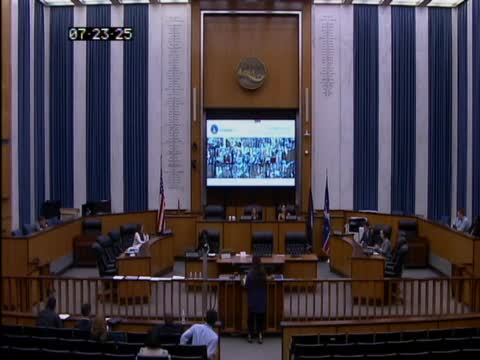Richmond Unveils Urban Heat Mitigation Strategies in New Cool Kit Guide
July 23, 2025 | Richmond City (Independent City), Virginia
This article was created by AI summarizing key points discussed. AI makes mistakes, so for full details and context, please refer to the video of the full meeting. Please report any errors so we can fix them. Report an error »

Richmond City officials unveiled a groundbreaking initiative aimed at combating rising urban temperatures during the Governmental Operations Standing Committee meeting on July 23, 2025. Daniel Klein, the city’s sustainability coordinator, introduced the Richmond Cool Kit, an urban heat mitigation guide designed to help the community adapt to increasing heat levels.
The Cool Kit outlines 25 strategies to reduce urban heat, which is exacerbated by the prevalence of buildings, roads, and limited vegetation in city environments. Klein emphasized that the guide serves not only city staff but also businesses and homeowners, providing practical solutions for integrating cooling strategies into private properties.
Key strategies highlighted in the Cool Kit include urban greening—such as planting street trees and creating green infrastructure—blue spaces like splash pads, and the implementation of smart surfaces that reflect heat. Klein also discussed the importance of providing shade in public spaces to protect residents from heat-related illnesses.
The urgency of this initiative is underscored by alarming statistics presented during the meeting. Richmond has seen a significant increase in extreme heat days, with projections indicating that by 2070, residents could experience up to 36 days per year exceeding 100 degrees Fahrenheit. This trend raises concerns about public health, safety, and overall community well-being.
Klein noted that the Cool Kit aligns with the city’s sustainable design standards and is part of a broader effort to enhance climate resilience. Workshops for city staff will be organized to ensure these strategies are effectively integrated into future projects.
The meeting concluded with a strong call to action, highlighting the need for immediate implementation of these strategies to mitigate the impacts of climate change on Richmond’s residents. As Klein aptly stated, “The best time to plant a tree is 20 years ago. The second best time is now.”
The Cool Kit outlines 25 strategies to reduce urban heat, which is exacerbated by the prevalence of buildings, roads, and limited vegetation in city environments. Klein emphasized that the guide serves not only city staff but also businesses and homeowners, providing practical solutions for integrating cooling strategies into private properties.
Key strategies highlighted in the Cool Kit include urban greening—such as planting street trees and creating green infrastructure—blue spaces like splash pads, and the implementation of smart surfaces that reflect heat. Klein also discussed the importance of providing shade in public spaces to protect residents from heat-related illnesses.
The urgency of this initiative is underscored by alarming statistics presented during the meeting. Richmond has seen a significant increase in extreme heat days, with projections indicating that by 2070, residents could experience up to 36 days per year exceeding 100 degrees Fahrenheit. This trend raises concerns about public health, safety, and overall community well-being.
Klein noted that the Cool Kit aligns with the city’s sustainable design standards and is part of a broader effort to enhance climate resilience. Workshops for city staff will be organized to ensure these strategies are effectively integrated into future projects.
The meeting concluded with a strong call to action, highlighting the need for immediate implementation of these strategies to mitigate the impacts of climate change on Richmond’s residents. As Klein aptly stated, “The best time to plant a tree is 20 years ago. The second best time is now.”
View full meeting
This article is based on a recent meeting—watch the full video and explore the complete transcript for deeper insights into the discussion.
View full meeting
